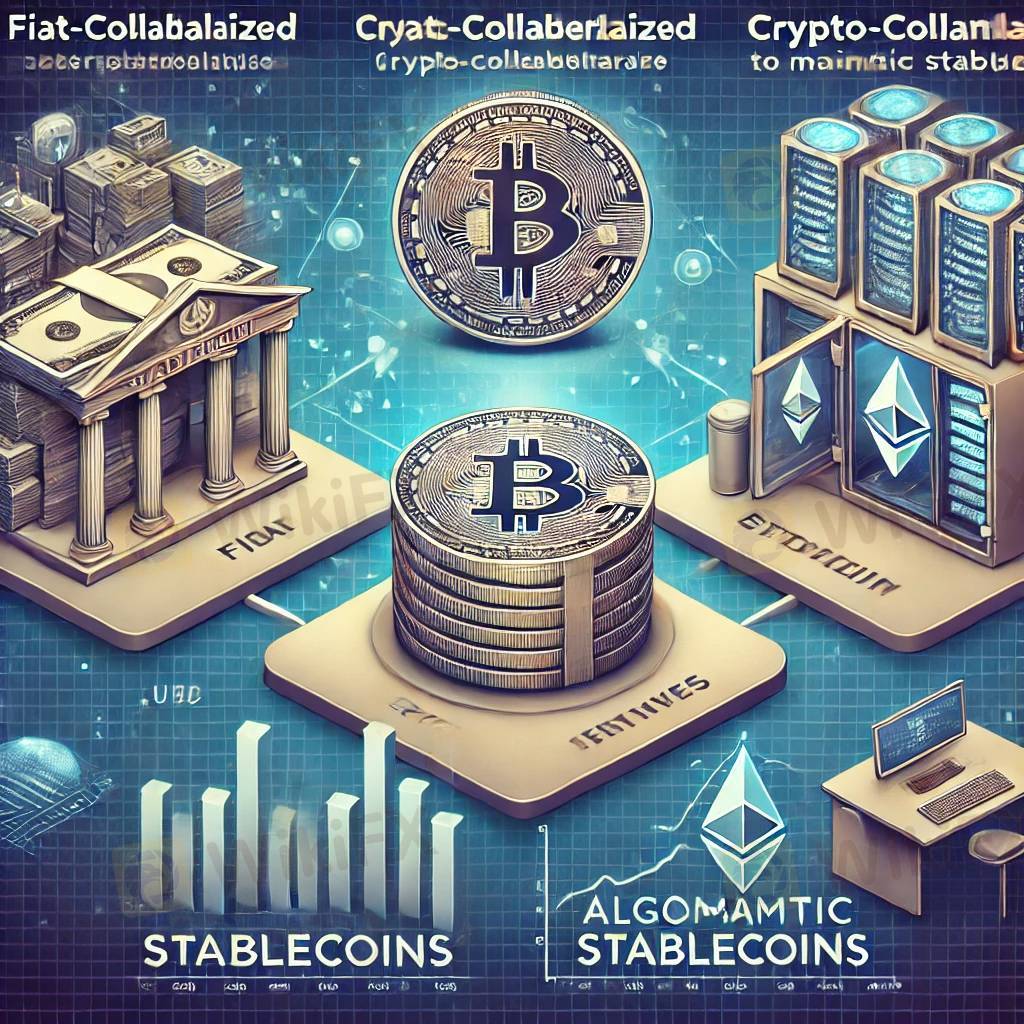
2025-02-15 16:39
IndustryTypes of Stablecoins: Understanding Their Differen
#Firstdealofthenewyearastylz
Introduction
Stablecoins are designed to provide price stability in the crypto market, but not all stablecoins function the same way. They can be classified into three main types based on their collateral and stabilization mechanisms: Fiat-collateralized, Crypto-collateralized, and Algorithmic stablecoins.
Each type has its advantages and risks, making them suitable for different use cases in trading, payments, and decentralized finance (DeFi). Let’s explore how they work and their key differences.
---
1. Fiat-Collateralized Stablecoins
Definition:
Fiat-collateralized stablecoins are backed by traditional currencies like the U.S. dollar (USD), Euro (EUR), or commodities like gold. Each stablecoin in circulation is supported by an equivalent amount of fiat held in reserve by a centralized entity, ensuring a stable value.
Examples:
Tether (USDT) – The most widely used stablecoin, backed primarily by cash and short-term assets.
USD Coin (USDC) – Issued by Circle and Coinbase, with regular audits to ensure full fiat backing.
Pax Dollar (USDP) – Regulated and backed by cash reserves for transparency.
Pros:
✔ High stability due to fiat backing
✔ Widely accepted in trading and payments
✔ Regulated and regularly audited
Cons:
✘ Requires trust in centralized issuers
✘ Risk of reserve mismanagement or lack of transparency
✘ Potential regulatory restrictions
---
2. Crypto-Collateralized Stablecoins
Definition:
Crypto-collateralized stablecoins are backed by digital assets like Ethereum (ETH) instead of fiat currency. Since cryptocurrencies are volatile, these stablecoins require over-collateralization (holding more assets than the stablecoin value) to maintain stability.
Example:
Dai (DAI) – Maintained by MakerDAO, backed by ETH and other crypto assets through a decentralized system. Users lock their crypto as collateral to generate DAI.
Pros:
✔ Fully decentralized, reducing reliance on traditional financial systems
✔ Transparent and secure through smart contracts
✔ Allows users to leverage their crypto holdings
Cons:
✘ Higher risk due to crypto market volatility
✘ Requires over-collateralization (e.g., depositing $150 in ETH to generate $100 in DAI)
✘ Liquidation risks during market crashes
---
3. Algorithmic Stablecoins
Definition:
Algorithmic stablecoins maintain their peg without direct asset backing. Instead, they use smart contract-based supply and demand mechanisms to stabilize prices. These mechanisms automatically increase or decrease the supply of stablecoins based on market conditions.
Example:
Frax (FRAX) – A hybrid model that combines partial collateralization with algorithmic adjustments to maintain stability.
Pros:
✔ Fully decentralized and autonomous
✔ No need for over-collateralization
✔ Scalable and adaptable to market conditions
Cons:
✘ Higher risk of de-pegging during market stress
✘ Algorithmic failures can lead to collapses (e.g., Terra UST in 2022)
✘ Less proven compared to fiat-backed or crypto-backed models
---
Comparison Table: Stablecoin Types
---
Conclusion
Stablecoins provide a bridge between traditional finance and the crypto world, each with unique strengths and trade-offs. Fiat-backed stablecoins offer reliability, crypto-backed stablecoins prioritize decentralization, and algorithmic stablecoins aim for scalability.
Choosing the right stablecoin depends on the user's needs—whether it’s trading, investment, or decentralized finance (DeFi). However, as the market evolves, regulation and transparency will play a crucial role in shaping the future of stablecoins.
Like 0

Shelfdon7
Brokers
Hot content
Industry
Event-A comment a day,Keep rewards worthy up to$27
Industry
Nigeria Event Giveaway-Win₦5000 Mobilephone Credit
Industry
Nigeria Event Giveaway-Win ₦2500 MobilePhoneCredit
Industry
South Africa Event-Come&Win 240ZAR Phone Credit
Industry
Nigeria Event-Discuss Forex&Win2500NGN PhoneCredit
Industry
[Nigeria Event]Discuss&win 2500 Naira Phone Credit
Forum category

Platform

Exhibition

Agent

Recruitment

EA

Industry

Market

Index
Types of Stablecoins: Understanding Their Differen
 Hong Kong | 2025-02-15 16:39
Hong Kong | 2025-02-15 16:39#Firstdealofthenewyearastylz
Introduction
Stablecoins are designed to provide price stability in the crypto market, but not all stablecoins function the same way. They can be classified into three main types based on their collateral and stabilization mechanisms: Fiat-collateralized, Crypto-collateralized, and Algorithmic stablecoins.
Each type has its advantages and risks, making them suitable for different use cases in trading, payments, and decentralized finance (DeFi). Let’s explore how they work and their key differences.
---
1. Fiat-Collateralized Stablecoins
Definition:
Fiat-collateralized stablecoins are backed by traditional currencies like the U.S. dollar (USD), Euro (EUR), or commodities like gold. Each stablecoin in circulation is supported by an equivalent amount of fiat held in reserve by a centralized entity, ensuring a stable value.
Examples:
Tether (USDT) – The most widely used stablecoin, backed primarily by cash and short-term assets.
USD Coin (USDC) – Issued by Circle and Coinbase, with regular audits to ensure full fiat backing.
Pax Dollar (USDP) – Regulated and backed by cash reserves for transparency.
Pros:
✔ High stability due to fiat backing
✔ Widely accepted in trading and payments
✔ Regulated and regularly audited
Cons:
✘ Requires trust in centralized issuers
✘ Risk of reserve mismanagement or lack of transparency
✘ Potential regulatory restrictions
---
2. Crypto-Collateralized Stablecoins
Definition:
Crypto-collateralized stablecoins are backed by digital assets like Ethereum (ETH) instead of fiat currency. Since cryptocurrencies are volatile, these stablecoins require over-collateralization (holding more assets than the stablecoin value) to maintain stability.
Example:
Dai (DAI) – Maintained by MakerDAO, backed by ETH and other crypto assets through a decentralized system. Users lock their crypto as collateral to generate DAI.
Pros:
✔ Fully decentralized, reducing reliance on traditional financial systems
✔ Transparent and secure through smart contracts
✔ Allows users to leverage their crypto holdings
Cons:
✘ Higher risk due to crypto market volatility
✘ Requires over-collateralization (e.g., depositing $150 in ETH to generate $100 in DAI)
✘ Liquidation risks during market crashes
---
3. Algorithmic Stablecoins
Definition:
Algorithmic stablecoins maintain their peg without direct asset backing. Instead, they use smart contract-based supply and demand mechanisms to stabilize prices. These mechanisms automatically increase or decrease the supply of stablecoins based on market conditions.
Example:
Frax (FRAX) – A hybrid model that combines partial collateralization with algorithmic adjustments to maintain stability.
Pros:
✔ Fully decentralized and autonomous
✔ No need for over-collateralization
✔ Scalable and adaptable to market conditions
Cons:
✘ Higher risk of de-pegging during market stress
✘ Algorithmic failures can lead to collapses (e.g., Terra UST in 2022)
✘ Less proven compared to fiat-backed or crypto-backed models
---
Comparison Table: Stablecoin Types
---
Conclusion
Stablecoins provide a bridge between traditional finance and the crypto world, each with unique strengths and trade-offs. Fiat-backed stablecoins offer reliability, crypto-backed stablecoins prioritize decentralization, and algorithmic stablecoins aim for scalability.
Choosing the right stablecoin depends on the user's needs—whether it’s trading, investment, or decentralized finance (DeFi). However, as the market evolves, regulation and transparency will play a crucial role in shaping the future of stablecoins.
Like 0
I want to comment, too
Submit
0Comments

There is no comment yet. Make the first one.

Submit
There is no comment yet. Make the first one.